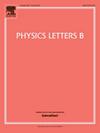Hypernuclear cluster states of BΛ12 unveiled through neural network-driven microscopic calculation
IF 4.3
2区 物理与天体物理
Q1 ASTRONOMY & ASTROPHYSICS
引用次数: 0
Abstract
We investigate the hypernuclear cluster states of using a neural-network-driven microscopic model. We extend the Control Neural Networks (Ctrl.NN) method and systematically calculate the positive-parity spectrum of . By incorporating sd-shell excitations and parity-coupling effects into the hypernuclear system, we reveal structural changes, including clustering effects and new configurations such as isosceles-triangle and α-t-α linear-chain structures. Furthermore, by comparing with experimental data, we identify that many peaks (#6 and #8) can be interpreted as dominant states, which is consistent with shell-model predictions. Notably, based on our analysis of the excited states of , we propose possible candidates for previously unexplained or controversial experimental peaks.
求助全文
约1分钟内获得全文
求助全文
来源期刊

Physics Letters B
物理-物理:综合
CiteScore
9.10
自引率
6.80%
发文量
647
审稿时长
3 months
期刊介绍:
Physics Letters B ensures the rapid publication of important new results in particle physics, nuclear physics and cosmology. Specialized editors are responsible for contributions in experimental nuclear physics, theoretical nuclear physics, experimental high-energy physics, theoretical high-energy physics, and astrophysics.
 求助内容:
求助内容: 应助结果提醒方式:
应助结果提醒方式:


